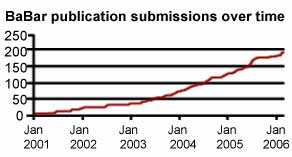
Handy Links
SLAC News Center
SLAC Today
- Subscribe
- Archives: Feb 2006-May 20, 2011
- Archives: May 23, 2011 and later
- Submit Feedback or Story Ideas
- About SLAC Today
SLAC News
Lab News
- Interactions
- Lightsources.org
- ILC NewsLine
- Int'l Science Grid This Week
- Fermilab Today
- Berkeley Lab News
- @brookhaven TODAY
- DOE Pulse
- CERN Courier
- DESY inForm
- US / LHC
SLAC Links
- Emergency
- Safety
- Policy Repository
- Site Entry Form

- Site Maps
- M & O Review
- Computing Status & Calendar
- SLAC Colloquium
- SLACspeak
- SLACspace
- SLAC Logo
- Café Menu
- Flea Market
- Web E-mail
- Marguerite Shuttle
- Discount Commuter Passes
-
Award Reporting Form
- SPIRES
- SciDoc
- Activity Groups
- Library
Stanford
Around the Bay
BaBar Submits 200th Paper
 Last week, the BaBar collaboration celebrated a major milestone: the submission of its
200th paper.
Last week, the BaBar collaboration celebrated a major milestone: the submission of its
200th paper.
"This is a remarkable accomplishment for BaBar, whose first paper, a study of time-dependent CP violation, was published barely five years ago," said BaBar Spokesperson David MacFarlane. "Equally impressive is the breadth of physics topics being addressed, with the promise of many more exciting results from the rapid accumulation of new data."
The 200th paper, titled "Measurement of B0àD(*)0 K(*)0 Branching Fractions," describes a new approach to measuring accurately the angle gamma in the unitarity triangle, one of three angles governing CP violation in B mesons. Although the new approach does not appear to work as well as theorists expected, it illustrates the approach at BaBar of constantly trying to invent new methods.
"This paper, like many published by BaBar, is also important for future experiments," said BaBar Physics Analysis Coordinator Riccardo Faccini. "It helps us understand what we may or may not be able to do at the LHC."
On average, BaBar has published one paper a week since mid-2004, in Physical Review Letters and Physical Review D. To submit a paper to such journals, the analysis involved must go through several steps of rigorous internal assessment, all managed by the BaBar Publications Board. All 200 BaBar papers have undergone this same arduous process, designed to ensure the quality of the result, while also producing a clear and coherent presentation.
Among the latest publications on the decays of the B mesons, the main purpose for building BaBar, are results from the study of the properties of the leptons in the BàXsll decays, which are highly sensitive to possible contributions from unseen physics processes, a search of CP violation with an unprecedented sensitivity of 0.3% in events where both the B mesons decays through semileptonic channels, and the most accurate single measurements of the side Vub of the unitarity triangle.
The wide breadth of physics addressed in BaBar’s publications is equally impressive. The BaBar detector was built to conduct experiments on the decay of b-mesons. Yet about 30 percent of BaBar papers focus on charm and tau particles—a branch of research for which the detector excels, but was not specifically designed. The recent list of publications includes the observation of a new charmed baryon (the Λc(2880)), a detailed study of the decays of the recently discovered DsJ(2316) and DsJ(2460) mesons, the search for the lepton flavor violating decay of the tau lepton into an electron and a photon, and the first observation of decays of the Υ(4S) mesons into other Υ mesons and two pions, which helps clarifying our understanding of spectroscopy.
"We have become a b-factory, a tau-factory and a charm-factory," said Faccini. "This makes us competitive in several fields of particle physics."
With its 200th paper, BaBar celebrates five years of broad-ranging, significant science publications. BaBar researchers look forward to many more publications in the future and appear on track to reach 250 papers by early 2007.
—Kelen Tuttle
SLAC Today, April 19, 2006